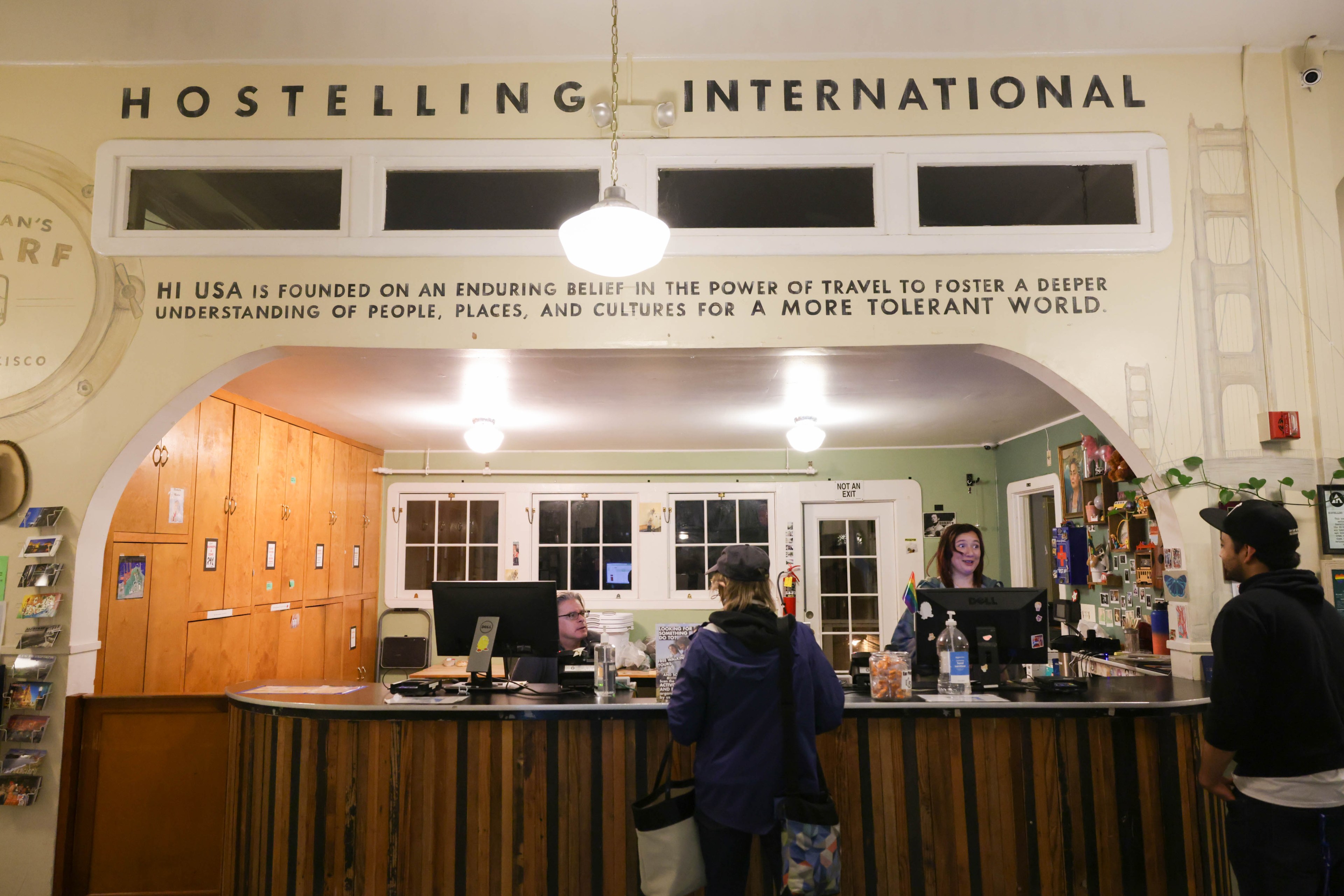The view from the double bed would be worthy of a five-star hotel: the serene green of Fort Mason sloping toward the Marina, the Golden Gate Bridge stretched out like a welcome mat, the rock of Alcatraz Island studding San Francisco Bay.
But it’s not a five-star hotel, or even a hotel at all. It’s Hostelling International’s Fisherman’s Wharf hostel, perched on a gorgeous bluff above Aquatic Cove, where private room No. 23 sets back guests as little as $100 a night. Visitors won’t have their own bathroom, but they can enjoy a cozy common area with a crackling fireplace, an in-house theater, an expansive shared kitchen and free breakfast.
The hostel—housed in a historic 1863 building that once billeted Civil War soldiers—is one of nine such affordable accommodations scattered around the city. While San Francisco hostels have long attracted young and crunchy international travelers on a budget, the city’s bargain beds are now giving Airbnbs a run for their money by offering more than just affordability.
Hostels’ increased privacy and perks are attracting a wider range of ages and demographics. The Music City hostel in Lower Nob Hill—which recently underwent a major overhaul—has rooms equipped with guitars and amps for practicing. The hotel-like Samesun on Lombard Street includes free parking and private rooms. The funky Green Tortoise Hostel in North Beach features zany carpeting, a boho common area and a free dry sauna.
“We’re very bullish about where San Francisco is going to be in two to three years,” said Russ Hedge, president and CEO of Hostelling International USA, the largest hostelling network in the world. The company also operates a location in Union Square and a pair of famed lighthouse lodgings down the coast in Montara and Pigeon Point, where you can fall asleep to crashing surf for as little as $45 a night. While Hostelling International closed one of its Downtown hostels during the pandemic, the company is now actively scouting a new location in the city.
All of this is conspiring to make the hostelling scene something it hasn’t been in at least a generation: broadly desirable. Across the country, elaborate amenities like rooftop pools and steam rooms have led some to speculate that hostels are poised to overtake Airbnbs as accommodations of choice.
Gallery of 9 photos
the slideshow
“Guests want the social vibe that comes with staying at the hostel,” Hedge said. “But they also want a level of privacy that probably didn’t exist 20 to 30 years ago.”
That has led to changes like more private rooms, more single-stall bathrooms and private changing areas in shower rooms, amenities that didn’t exist in hostels a decade or two ago.
Even though hotel bargains are hard to come by in high-cost San Francisco, you can score a hostel bed for as little as $28 in the heart of the city with amenities galore—so why are so many of them only half full?
Perception Is Everything
With their prime locations, array of amenities and basement prices, hostels could be a stiff competitor to Airbnb, which witnessed a rise in vacancy rates last year. But both forms of accommodations appear to be suffering from the same problem: the negative narrative surrounding San Francisco.
“The doom loop narrative is keeping people away,” said Ruben Ortiz. The general manager of Hostelling International’s Fisherman’s Wharf hostel cited a recent school group—50 kids from the United Kingdom—that canceled their reservation because of what they were seeing on the news.
Overnights in San Francisco hostels were down 15% in 2023 as compared with 2019—whereas that rate is only 8% in the rest of the country, Hedge said. The Hostelling International president attributes the San Francisco drop to the lack of a rebound in travel from China and the Asian rim. But it’s not only that.
“Our travelers are quite well-informed,” he said. “So if there is media coverage that raises questions about a city or a neighborhood, they’ll take that into account in terms of their travel plans.”
At the European Hostel on SoMa’s Minna Street, that kind of news was happening in real time during a visit by The Standard. “Tourists are very scared to come to this street right now,” said receptionist Nikunj Upadhyay on the phone, while registering a guest’s complaint about people doing drugs outside his front door. “There are kids staying here.”
The capacity at Green Tortoise is currently under 50%, lower than is typical for the slow winter season, when occupancy rates usually hover above 60%. The Fisherman’s Wharf and Samesun hostels are also below 50% occupancy.
Yet despite all the negativity in the ether, hostel guests interviewed by The Standard only had positive things to say about the city, highlighting its beauty and the friendliness of the residents.
“It’s a great city,” said Samesun guest Renata Paulo, who traveled from Washington, D.C., to celebrate New Year’s Eve. “I can’t wait to come back.”
The Hostelling International president, for his part, remains optimistic about the future of San Francisco—and about what hostels can provide for it. “Our guests have felt so welcomed by the people of San Francisco,” he said. “There’s an attitude that distinguishes it from other cities, a graciousness.”
What’s more, hostels can host group sizes not possible in Airbnbs, like touring cyclists or large Girl Scout troops, like the one that overtakes the Fisherman’s Wharf hostel every year.
“The whole place fills up with little girls,” Ortiz said. “And the chaperone moms sipping on their chardonnay, saying, ‘We have to drink to get through this.’”
